In the late 16th century, Rome, Florence and Venice ranked as Italy's most important centres of art. It was from there that, through painters like Raphael, Titian, Annibale Carracci and Michelangelo da Caravaggio, significant impulses for the stylistic change of art in Europe emanated. Giovanni Salvi (Il Sassoferrato), for example, mainly oriented himself in his compositions to Raphael, while Tintoretto in his portraiture picked up on Titian's Venetian type of painting by depicting a person in dark clothing against a neutral grey background. But above all, it was Caravaggio, with his dramatic use of light and shadow(s) (tenebrismo), who inspired and influenced the subsequent generation of Baroque painters. His follower Bartolomeo Manfredi is still hailed today as one of the most prominent figures of international Caravaggism. The Spanish artist Jusepe de Ribera, who lived in Naples, carried this style onwards, indirectly influencing his compatriot Francisco de Zurbarán, who was working under contract for rigidly pious monastic orders. In counter-reformist Spain, his penchant for religious subjects attracted great interest among his predominantly ecclesiastical clients. Unlike in the northern provinces of the Netherlands, the middle classes in Spain played hardly any role as clients or buyers of art. Particularly Zurbarán’s depictions of St Francis, of whom he painted over 50 versions, distinguish him as a truly virtuoso master of light and shadows.
The majority of the Spanish paintings in the Suermondt Ludwig Museum come from the internationally renowned 19th-century collection of Colonel Andreas Daniel Berthold von Schepeler, a German officer who was active as a diplomat, historian, military theorist, man of letters and art collector. He possessed one of the most important collections of paintings, especially of Spanish and Dutch art. He did his own collecting personally in Spain between 1815 and 1832. Most of the items came from the holdings of noble families who were forced to sell their art collections after the revolution in Spain. In 1852, three years after Schepeler's death, Barthold Suermondt bought his collection, which numbered around 150 paintings. Many of these are now located in the former Suermondt Collection in Berlin, to which Suermondt himself was forced to sell the first part of his collection in 1874. But several important works have remained in Aachen, for example Christ Carrying the Cross.
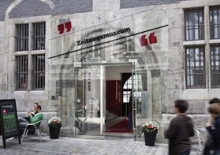
Medienmuseum, Wechselausstellungen und eine Sammlung von 200.000 Zeitungen und Druckwerken in nahezu allen Sprachen.
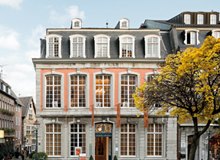
Das bekannteste Wohnzimmer Aachens, mit anschaulichen Einblicken in die Wohnkultur des 18. und frühen 19. Jahrhunderts.

UNESCO-Weltkulturerbe mit herausragender künstlerischer Ausstattung: Karlsschrein, aufwändigen Mosaiken, einer goldenen Altartafel.
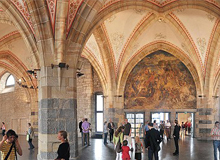
Die größten Historienbilder der Romantik, originalgetreue Kopien des Säbels Karls des Großen, einer karolingischen Handschrift, der Reichskrone.
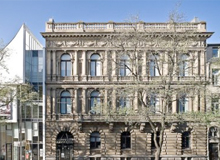
Kunst von der Gegenwart bis in die Antike, mit hervorragenden Gemälden und Skulpturen des Spätmittelalters sowie der Malerei des 17. Jhs.
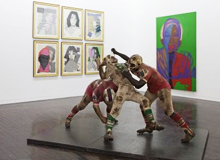
Schauplatz für zeitgenössische Künstler und Kunstwerke, Begegnungsstätte darstellender und bildender Kunst, Bestände der Sammlung Ludwig.
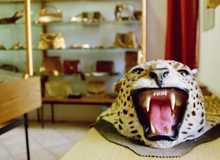
Lebendiges Zentrum zur Erinnerung der Grenzgeschichte und -geschichten, mit verbotenen Souvenirs und Schwarzbrennerei.

Eröffnung 2014 – Lebendige Geschichte von den Karolingern bis heute. Ausgangspunkt der Route Charlemagne am historischen Katschhof.

Stolz blicken die Aachener auf ihre Geschichte als römische Bäderstadt und Kaiserresidenz Karls des Großen zurück. Der Dom, 1978 zum ersten UNESCO Weltkulturerbe in Deutschland ernannt, und das Rathaus bilden den Mittelpunkt der Stadt. In den Gassen der Altstadt erzählen viele historische Gebäude von der lebhaften Geschichte der Stadt, und doch ist die Zeit nicht stehen geblieben.
An der „Eliteuni“ RWTH Aachen und den anderen Hochschulen sind rund 40.000 Studenten eingeschrieben. Das junge Leben pulsiert vor allem im Pontviertel, dem beliebten Ausgehviertel mit seinen zahlreichen Cafés, Kneipen und Restaurants. Doch auch in den Gassen und auf den Plätzen der Altstadt ist immer viel los. Rund um Dom und Rathaus laden zahlreiche Einzelhändler ebenso wie Filialen namhafter Häuser zum Bummeln ein.
Quelle allen Ruhms ist das Wasser: Die Heilkraft der heißen Thermalquellen war ausschlaggebend dafür, dass Kaiser Karl Aachen zu seiner Lieblingsresidenz machte. Die Badetradition wird heute durch die Carolus Thermen Bad Aachen weitergeführt.
Wer sich lieber in der Natur entspannt, hat dafür zahlreiche Möglichkeiten, etwa im nahe gelegenen Nationalpark Eifel. Zudem locken mehrere Theater und Museen mit einem vielschichtigen Angebot.

